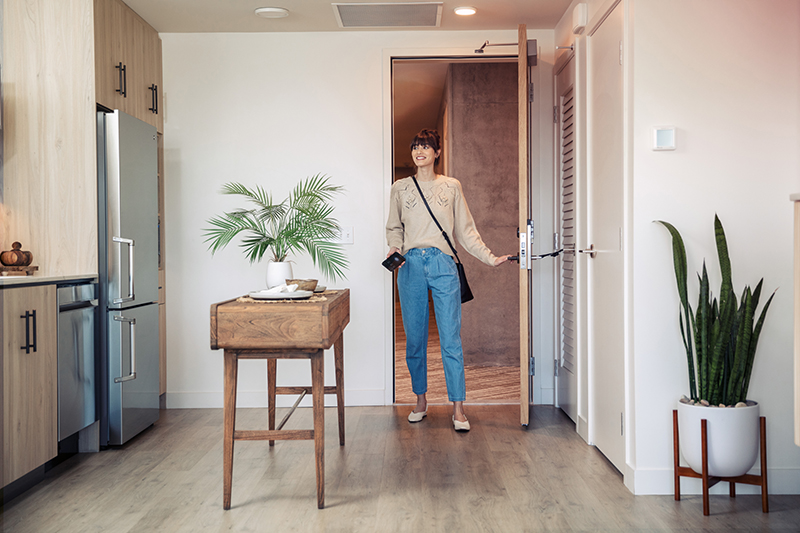As the multifamily property sector continues to grow, security is an increasingly crucial factor in the decision to rent, or eventually buy, a property. Brivo’s Lee Miller, Senior Director of Multifamily Sales, explains why PropTech and digital first security solutions are becoming essential for property managers and their tenants.

Lee Miller, Senior Director of Multifamily Sales, Brivo
In the UK’s unpredictable housing market, rentals are a necessary choice for those who can’t afford to buy. So much so, it is predicted that by 2025 over 50% of adults under the age of 40 will be in private rented accommodation.
Multifamily – a residential property that contains more than one housing unit, like a block of flats – is a big growth area for this market, with four consecutive record-breaking years for investment and forecasts of an additional 6.5% growth for rental in 2023.
There are efforts to meet this high demand with better supply – for example in London alone there is a target to add over half a million new homes in the next decade. This will create more competition, and those developing and managing multifamily rentals have a number of responsibilities to take on.
While multiple factors contribute to someone’s decisions to rent (price, location, size), one area that is increasingly important is how secure their new home is. One report found that 63% of millennials would move out of an apartment due to a lack of security.
And it’s not just the home being secure, the tenant also needs to feel secure – one without the other means either a false sense of security, or uneasiness about the effectiveness of security and sleepless nights even if there’s no reason for it.
Those that own and run multifamily residential properties need to be particularly wise to this, as their tenants cede control of security to them. Therefore, while attracting and retaining tenants will depend on many factors, security and its perception is a crucial consideration.
Given the digital-first world we now live in, PropTech and smart security solutions will be essential in ensuring each tenant feels as secure as possible.
The PropTech hierarchy
Investments in PropTech hit a new record of $12.9 billion in the first half of 2019 and only continued to grow with the restrictions implemented at the peak of the Coronavirus outbreak. People wanted security and access management at the click of a button, without risking physical contact or virus exposure.
In short, PropTech incorporates all the software and smart devices present in residential and commercial real estate. It is an important part of not just securing a building, but also demonstrating to tenants that the utmost is being done to protect them and their belongings.
However, it’s important that property owners and managers recognise that PropTech enhancements are not something they can or should implement all at once. Don’t assume new features will work together to create a perfect, secure living experience for the tenants.
Instead, managers need to start with the basics. In other words, the tenants’ most critical physical security needs and expectations, and then build gradually on this foundation to establish an integrated offering.
It is easiest to view PropTech in a hierarchy with four key stages; physical security and safety, resident belonging and retention; property appeal; and futureproofing.
It is this very first, foundational step that will be important to ensuring tenants feel secure.
One easy solution to begin the process is implementing cameras at entry points and high traffic areas to ensure these sites are monitored 24/7/365.
Residents of multifamily homes also need reassurance that only those authorised to do so can get inside their building, so smart lock systems are a must and can be available for any budget.
The benefits of cloud-based access control
Access control is critical in boosting the resident’s sense of security within a building. Yet today, traditional keys and even access cards are becoming outdated.
With cloud-based access control, keys and fobs can be replaced with tenant’s mobile phones, cultivating a more secure and convenient access process. It offers tenants more control, as they can easily and securely grant access to visitors via their mobiles.
Cloud-enabled access technologies also allow more control for property managers and owners, who do not need to be on site to bolster the security of their facilities. Cloud technology can be accessible from any location, meaning managers can remotely manage multiple properties and grant, deny or completely remove access if they deem necessary and to protect their tenants.
The technology also makes attracting new tenants an easier process – it accommodates secure after-hours tours for prospective renters and enables property managers to focus on the more complex property needs.
For example, with smart locks meaning less maintenance call outs for lost keys, managers can be investing time and money into reaching the next stages of the PropTech hierarchy. That is, improving tenant experience, retention and futureproofing facilities.
As multifamily rentals continue to grow in popularity, so too will the options that renters have available to them. Smart technology is invaluable for property managers and owners looking to welcome prospective tenants and eventually evolve their PropTech offering into a fully integrated, secure and smart residence.
Cloud-based solutions will undoubtedly be the foundation for this, with cloud-enabled access control not only crucial for making buildings more secure, but also ensuring tenants feel confident that they are.
Listen to Lee Odess discuss the evolution of access control and increasing role of PropTech in the sector on the IFSEC Insider podcast, below…


